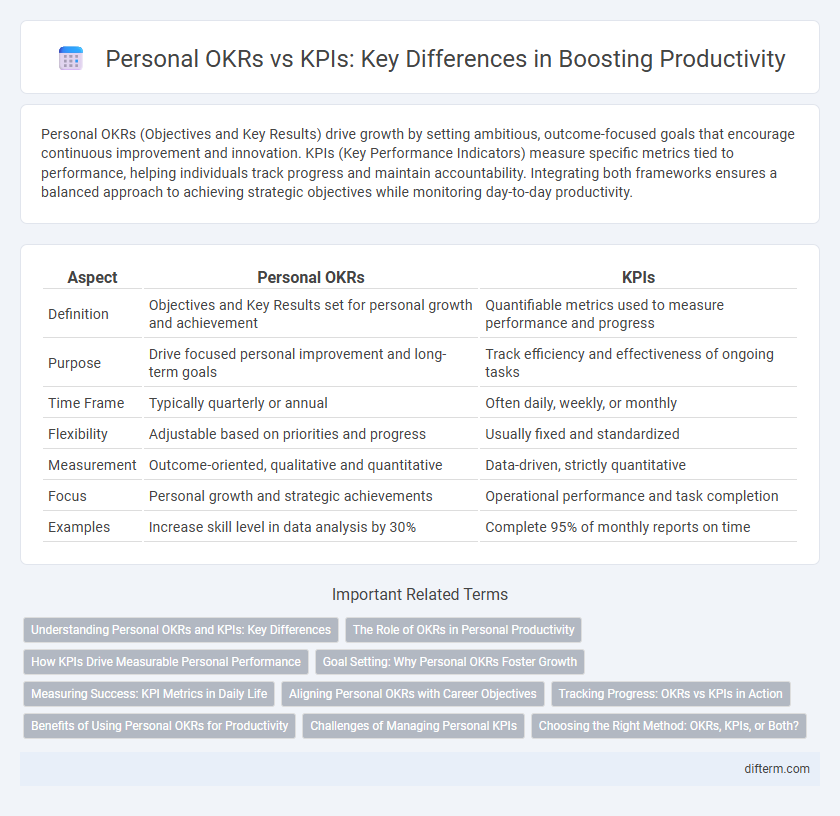Personal OKRs (Objectives and Key Results) drive growth by setting ambitious, outcome-focused goals that encourage continuous improvement and innovation. KPIs (Key Performance Indicators) measure specific metrics tied to performance, helping individuals track progress and maintain accountability. Integrating both frameworks ensures a balanced approach to achieving strategic objectives while monitoring day-to-day productivity.
Table of Comparison
| Aspect | Personal OKRs | KPIs |
|---|---|---|
| Definition | Objectives and Key Results set for personal growth and achievement | Quantifiable metrics used to measure performance and progress |
| Purpose | Drive focused personal improvement and long-term goals | Track efficiency and effectiveness of ongoing tasks |
| Time Frame | Typically quarterly or annual | Often daily, weekly, or monthly |
| Flexibility | Adjustable based on priorities and progress | Usually fixed and standardized |
| Measurement | Outcome-oriented, qualitative and quantitative | Data-driven, strictly quantitative |
| Focus | Personal growth and strategic achievements | Operational performance and task completion |
| Examples | Increase skill level in data analysis by 30% | Complete 95% of monthly reports on time |
Understanding Personal OKRs and KPIs: Key Differences
Personal OKRs (Objectives and Key Results) emphasize ambitious goal-setting with measurable outcomes to inspire continuous growth, while KPIs (Key Performance Indicators) track specific performance metrics to assess efficiency and progress. OKRs often drive strategic alignment and personal development over a set period, whereas KPIs focus on ongoing performance measurement related to operational targets. Understanding these differences helps individuals tailor productivity frameworks that foster motivation and precise performance evaluation.
The Role of OKRs in Personal Productivity
OKRs (Objectives and Key Results) drive personal productivity by setting ambitious, measurable goals that align daily tasks with long-term aspirations, fostering focus and motivation. Unlike KPIs (Key Performance Indicators), which track specific performance metrics, OKRs emphasize progress toward meaningful outcomes, encouraging continuous improvement and adaptability. This goal-setting framework enhances self-accountability and prioritization, leading to more effective time management and higher productivity levels.
How KPIs Drive Measurable Personal Performance
KPIs drive measurable personal performance by providing clear, quantifiable metrics that track progress toward specific goals, enabling continuous improvement and accountability. Unlike Personal OKRs, which focus on broader objectives and key results, KPIs offer precise data points that highlight areas of strength and pinpoint performance gaps. Tracking KPIs regularly helps individuals adjust strategies effectively, ensuring consistent productivity enhancements and goal achievement.
Goal Setting: Why Personal OKRs Foster Growth
Personal OKRs drive growth by emphasizing ambitious, qualitative objectives paired with measurable key results that encourage continuous progress and innovation. Unlike KPIs, which often track static metrics tied to performance standards, OKRs promote dynamic goal setting that adapts with evolving priorities and fosters proactive achievement. This structured yet flexible approach enhances motivation and clarity, leading to sustained personal development and productivity.
Measuring Success: KPI Metrics in Daily Life
KPI metrics in daily life serve as measurable indicators to track progress towards specific outcomes, offering real-time insights into productivity levels. Unlike personal OKRs, which outline broader goals and key results, KPIs focus on quantifiable data such as task completion rates, time management efficiency, and goal achievement consistency. Leveraging KPIs enables individuals to fine-tune habits and strategies, creating a data-driven approach to optimizing personal productivity.
Aligning Personal OKRs with Career Objectives
Aligning personal OKRs with career objectives ensures focused progress and meaningful outcomes by directly linking individual goals to long-term professional growth. OKRs emphasize ambitious, measurable targets that inspire development, while KPIs track ongoing performance metrics, making OKRs more effective for career alignment. Embedding career aspirations into personal OKRs drives motivation, clarity, and continuous skill advancement in productivity management.
Tracking Progress: OKRs vs KPIs in Action
Personal OKRs (Objectives and Key Results) emphasize ambitious goal-setting and measurable outcomes to drive significant progress, while KPIs (Key Performance Indicators) focus on tracking specific metrics to maintain consistent performance. OKRs provide a dynamic framework for tracking progress through regular check-ins and adaptability, encouraging continuous alignment with evolving priorities. KPIs offer clear, quantifiable data points that highlight operational efficiency and support targeted improvements in productivity.
Benefits of Using Personal OKRs for Productivity
Personal OKRs enhance productivity by providing clear, ambitious objectives aligned with measurable key results, fostering focused effort and continuous progress tracking. Unlike KPIs, which measure ongoing performance, OKRs drive growth through goal-setting that encourages innovation and prioritization of impactful tasks. This approach empowers individuals to achieve higher engagement, accountability, and measurable improvements in productivity outcomes.
Challenges of Managing Personal KPIs
Managing personal KPIs presents challenges such as setting quantifiable and relevant metrics that align with individual goals while avoiding overwhelm from excessive tracking. Difficulty arises in maintaining consistent measurement and adapting KPIs to evolving responsibilities, which can hinder accurate performance assessment. Lack of clear ownership and feedback loops often results in diminished motivation and suboptimal productivity outcomes.
Choosing the Right Method: OKRs, KPIs, or Both?
Personal OKRs (Objectives and Key Results) drive ambitious goal-setting by focusing on measurable outcomes and aligning efforts with long-term aspirations, while KPIs (Key Performance Indicators) track specific performance metrics to monitor ongoing progress and efficiency. Choosing the right method depends on individual priorities: OKRs suit those aiming for transformative growth and alignment, whereas KPIs are ideal for maintaining consistent performance in defined areas. Combining both offers a balanced approach, leveraging OKRs for strategic vision and KPIs for operational excellence.
Personal OKRs vs KPIs Infographic

 difterm.com
difterm.com